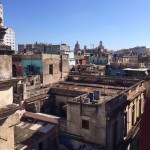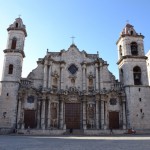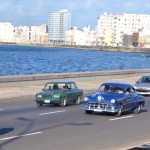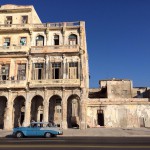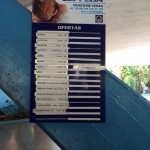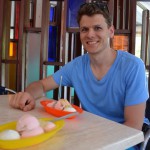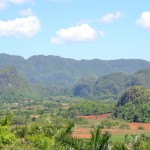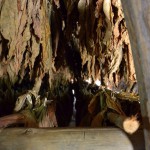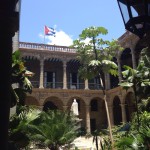After one day in Germany, we left, this time actually on our round-the-world ticket, for the second part of the trip. Owing to how we could best make the routing happen, getting to Cuba from Berlin involved four flight legs and an overnight stay in Panama City, so we only got to Havana in the afternoon of Monday 17 May. Our pickup from the airport to our accommodation was a 1950s Chevrolet – just as you imagine for Cuba, and while there are now some modern, mostly Asian, cars in the streets and there is also a large contingent of Ladas from the years as a Soviet ally, the share of vintage American cars is definitely still quite large.
Eager to move our legs after a day and a half of sitting on airplanes, we used the rest of the day to walk around Old Havana – Habana Vieja – and its four squares. Habana Vieja is full of history and amazing, grand colonial buildings – the city was founded soon after the discovery of the new world in the early 1500s. In post-revolutionary Cuba, many of the buildings fell into disrepair, and some are still literally crumbling or have collapsed. However, over the past couple of decades, the city historian, using tourist funds, has carefully and beautifully restored much of the old town, without completely shutting out ordinary Cuban life. The result makes for an interesting mix of tourists and Cubans going about their daily lives, and of posh hotels in grandiose mansions next to crumbling houses with shuttered windows, that nevertheless are home to Cuban families.
On Tuesday, we further explored the city, taking a hop-on/hop-off bus tour through Centro Habana and Vedado to the western suburbs of Playa and Miramar. We also got off in Vedado, to look at the huge concrete square Plaza de la Revolucion, which sports big murals of Che Guevara and Camilo Cienfuegos, two heroes of the revolution, as well as the big hotels that in the 1950s were the center of American partying and gambling in Cuba. In the most splendid of the hotels, Hotel Nacional, we had a mojito out in the leafy garden overlooking the water. The most memorable experience that day, however, was the visit to the ice cream parlor “Coppelia”, which was quintessentially communist. The way that this ice cream parlor worked only revealed itself to us gradually: first, we had to get in line. The line had formed around the block, and in the scorching tropical sun people tried to stick to the shady areas, which meant the line was broken up wherever there was no shade. New arrivals would frequently walk past the line asking “¿ultimo?” to see whether they had reached the end, or whether somewhere around the corner in the shade the line would continue. Every 10-15 minutes or so, the line moved when another batch of people was admitted to the parlor. We probably spent an hour and a half in line, but we didn’t really check. When we got to the front and were finally admitted, we realized that there would have been multiple queues, depending on which area of the parlor you wanted to be seated in – we obviously had no idea and just stuck with where we were shown. Entering the parlor, there was a board with the menu and another surprise: there were multiple different dishes (single scoop, multiple scoops, “salad”, …) but only one flavor: vanilla. And while outside, people were standing in line for two hours in the heat, inside there were two waiters for our area with 20 tables, and clearly not in a hurry. So it took a while until we had gotten our ice cream, a mixed plate with five scoops for both of us which to our delight included not only vanilla, but also strawberry. We were stuffed after that much ice cream, but Cubans all around us were eating two, three of these plates each! No idea how they managed that. Then came the time to pay. Cuba has a curious system with two parallel currencies, moneda nacional (CUP) and convertible pesos (CUC). Almost everything you pay as a tourist is charged in CUC, but this ice cream parlor was clearly not a tourist destination, so prices were quoted in CUP (and way below tourist prices). When we got ready to pay and pulled out a 3 CUC bill (which about equals 3 U.S. dollars), the people on the next table got all upset and motioned us to put it away, since it was way too much: for the ten scoops of ice cream we ended up paying only 0.50 CUC!
The next day, we did a day trip to the valley of Viñales. Unfortunately, we did not have planned for enough time in Cuba to stay in cities other than Havana, so the most we could do to see something else of the country was to leave Havana for a day. On the way, we also stopped by in Las Terrazas, which is Cuba’s first eco-resort and also contains the ruins of Cuba’s oldest, no longer operational coffee plantations. Viñales itself is revered for its landscape of huge limestone rocks and cliffs, that formed when underground rivers ate through the rock and caused much of the former highland to collapse, leaving only isolated mountains standing. One of these underground rivers we also got to see, when we visited the Cueva del Indio, a cave system with a river that tourists get ferried through in small boats. We also visited the town of Viñales in the middle of the valley, and much less busy and more relaxed than Havana. We had lunch on the rooftop of a casa particular (the family-run guesthouses in Cuba) in town, and walked around a bit to look at the picturesque town and valley. Before going back to Havana, we also visited a tobacco drying barn, where a local explained and demonstrated how to make cigars from the dried tobacco leaves. Of course, he also offered to sell us cigars, but as both non-smokers and with only cabin luggage, what would we have done with them? So we only gave him a nice tip and left. In the evening, back in Havana, we took an evening stroll along the Malecón, Havana’s famous seaside boardwalk, and then had dinner at Casa Migla, a Cuban-Swedish fusion restaurant. Decorated with Dalarna horses and other Swedish items, this restaurant is testament to the rapid development of Cuba’s culinary scene. For a long time, options for eating out in Cuba were limited, but since family-operated restaurants, called Paladars, were legalized, interesting and good food has become available, at least in Havana.
Thursday was particularly hot, so we took things a bit more slowly and visited two museums in town: the museum of the revolution, inside the former presidential palace, and the city museum next to the Plaza de Armas. The former was especially interesting, even though without knowing all the minutiae of how the revolution unfolded some of the exhibits that showed military movements and the like were hard to understand. The city museum showed various historic artifacts, but half of the museum was closed and the signage of the rest was not very good. However, the building itself, the Palacio de los Capitanes Generales, former seat of Spanish captains general, was well worth the visit, grand and imposing, centered around a huge courtyard. In the afternoon, we went to the Casa de la Musica, to witness some Cuban music (other than the numerous street musicians) first hand. The experience was definitely interesting, and we can report that Cuban music is alive and kicking – we knew beforehand that this particular Casa de la Musica was edgy, and the band “Kategoria 5″‘s take on Cuban music that included electronic elements and some mixture of singing and rapping was definitely a case in point. In the evening, we had dinner in another excellent restaurant in the old town, Doña Eutima.
On Friday, we already had to leave Cuba – again via Panama, from where we would depart for our next stop, Curaçao.
Some pictures follow.
- Taxi from the airport
- Havana
- Havana cathedral
- Malecón
- Cars on the Malecón
- Malecón houses
- Ice cream parlor queue
- Ice cream parlor menu
- Ice cream – vanilla AND strawberry!
- Viñales
- Drying tobacco in Viñales
- Swedish restaurant – Casa Miglis
- Museo de la Ciudad

